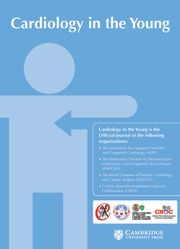No CrossRef data available.
Article contents
Higher left ventricular stroke volume is associated with aortic dilatation in repaired tetralogy of Fallot patients
Published online by Cambridge University Press: 23 October 2024
Abstract
Aortic root dilation has been reported commonly after repair of tetralogy of Fallot. However, the rate and risk factors of progression of the dilation are not fully understood. This is a single-centre, retrospective study to assess the rate and factors associated with progressive dilatation of the aortic root in repaired tetralogy of Fallot patients using cardiac MRI. The presence of the significant aortic dilation and the progression of dilation between initial and follow-up cardiac MRI were examined. The study cohort comprised 72 patients with repaired tetralogy of Fallot. The median age at the initial cardiac MRI scan was 19.6 (interquartile range: 14.6–31) years, and the median follow-up interval was 4.3 (2.9–5.7) years. Median dimension of ascending aorta at initial and follow-up cardiac MRI was 27.0 (22.3–31.0) mm and 29.2 (25.0–32.1) mm, respectively. Significant aortic dilation (the percentage predicted ascending aorta ≥150%) was observed in 11 (15.2%) patients at the initial cardiac MRI and 24 (33.3%) at the follow-up cardiac MRI. The significant aortic dilation at follow-up cardiac MRI was associated with increased indexed left ventricular stroke volume (odds ratio 1.062, p = 0.023). Thirteen patients demonstrated the significant progressive dilation of aorta between initial and follow-up cardiac MRI. The progressive dilation was associated with left ventricular ejection fraction at initial cardiac MRI (odds ratio 1.135, p = 0.048). In patients with repaired tetralogy of Fallot, aortic dilation is common and progresses over time. Cardiac MRI is a valuable tool for identifying individuals at risk for progressive aortic dilation.
- Type
- Original Article
- Information
- Copyright
- © The Author(s), 2024. Published by Cambridge University Press



